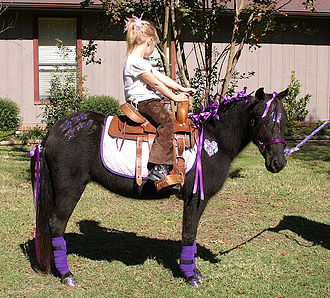m (- Category of AYHAB) |
|||
| (8 intermediate revisions by 3 users not shown) | |||
| Line 1: | Line 1: | ||
| − | {{Breed id | + | <noinclude><translate><!--T:1--> |
| + | </noinclude> | ||
| + | |||
| + | <!--T:2--> | ||
| + | {{ | ||
| + | |||
| + | <!--T:3--> | ||
| + | Breed id | ||
|name= Shetland Pony | |name= Shetland Pony | ||
|image=Urbanherovantbarreeltje.JPG | |image=Urbanherovantbarreeltje.JPG | ||
|image2=PurplePonyParty.jpg | |image2=PurplePonyParty.jpg | ||
| description = | | description = | ||
| − | The '''Shetland pony''' is a breed of pony originating in the Shetland Islands. | + | The '''Shetland pony''' is a breed of pony originating in the Shetland Islands. Shetlands range in size from a minimum height of approximately 28 inches to an official maximum height of 42 inches (10.2 hands, 107 cm) at the withers. (11.2 hands for American Shetlands) Shetland ponies have heavy coats, short legs and are considered quite intelligent. They are a very strong breed of pony, used for riding, driving, and pack purposes. |
| + | <!--T:4--> | ||
Shetland Ponies are hardy and strong, in part because the breed developed in the harsh conditions of the Shetland Islands. In appearance, Shetlands have a small head, sometimes with a dished face, wide spaced eyes and small, alert ears. The original breed has a short, muscular neck, compact, stocky bodies, and short, strong legs and a shorter than normal cannon bone in relation to their size. A short broad back and deep girth are universal characteristics as is a springy stride. Shetlands have long thick manes and tails and a dense double winter coat to withstand harsh weather. | Shetland Ponies are hardy and strong, in part because the breed developed in the harsh conditions of the Shetland Islands. In appearance, Shetlands have a small head, sometimes with a dished face, wide spaced eyes and small, alert ears. The original breed has a short, muscular neck, compact, stocky bodies, and short, strong legs and a shorter than normal cannon bone in relation to their size. A short broad back and deep girth are universal characteristics as is a springy stride. Shetlands have long thick manes and tails and a dense double winter coat to withstand harsh weather. | ||
| + | <!--T:5--> | ||
Shetlands can be almost every color, including skewbald and piebald (called ''pinto'' in the United States), but are mainly black, chestnut, bay, brown, gray, palomino, dun, roan, cremello, and silver dapple. | Shetlands can be almost every color, including skewbald and piebald (called ''pinto'' in the United States), but are mainly black, chestnut, bay, brown, gray, palomino, dun, roan, cremello, and silver dapple. | ||
| − | Shetland ponies are generally gentle, good-tempered, and very intelligent by nature. | + | <!--T:6--> |
| + | Shetland ponies are generally gentle, good-tempered, and very intelligent by nature. They make good children's ponies, but can be very opinionated or "cheeky," and, if not handled properly, can be impatient, snappy, and sometimes become uncooperative, traits often lumped under the label "stubborn" by those who fail to understand that pony behavior is influenced by the quality of human handling. Due in part to their intelligence and size, they are easily spoiled and can be very headstrong if not well-trained. | ||
| + | |||
| + | <!--T:7--> | ||
}} | }} | ||
| + | <noinclude></translate></noinclude> | ||
Latest revision as of 03:42, 15 July 2022
Shetland Pony
The Shetland pony is a breed of pony originating in the Shetland Islands. Shetlands range in size from a minimum height of approximately 28 inches to an official maximum height of 42 inches (10.2 hands, 107 cm) at the withers. (11.2 hands for American Shetlands) Shetland ponies have heavy coats, short legs and are considered quite intelligent. They are a very strong breed of pony, used for riding, driving, and pack purposes.
Shetland Ponies are hardy and strong, in part because the breed developed in the harsh conditions of the Shetland Islands. In appearance, Shetlands have a small head, sometimes with a dished face, wide spaced eyes and small, alert ears. The original breed has a short, muscular neck, compact, stocky bodies, and short, strong legs and a shorter than normal cannon bone in relation to their size. A short broad back and deep girth are universal characteristics as is a springy stride. Shetlands have long thick manes and tails and a dense double winter coat to withstand harsh weather.
Shetlands can be almost every color, including skewbald and piebald (called pinto in the United States), but are mainly black, chestnut, bay, brown, gray, palomino, dun, roan, cremello, and silver dapple.
Shetland ponies are generally gentle, good-tempered, and very intelligent by nature. They make good children's ponies, but can be very opinionated or "cheeky," and, if not handled properly, can be impatient, snappy, and sometimes become uncooperative, traits often lumped under the label "stubborn" by those who fail to understand that pony behavior is influenced by the quality of human handling. Due in part to their intelligence and size, they are easily spoiled and can be very headstrong if not well-trained.


